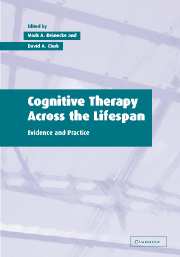Book contents
- Frontmatter
- Contents
- List of contributors
- Foreword
- 1 Cognitive therapy across the lifespan: conceptual horizons
- 2 Cognitive theory and therapy of depression
- 3 Cognitive theory and therapy of bipolar disorders
- 4 Regulation of emotion in generalized anxiety disorder
- 5 Cognitive theory and therapy of obsessions and compulsions
- 6 The cognitive model of panic
- 7 Treating obsessional problems using cognitive-behavioral therapy
- 8 Narcissistic personality disorder
- 9 Cognitive therapy and the self
- 10 Promoting cognitive change in posttraumatic stress disorder
- 11 Cognitive theory and therapy of social phobia
- 12 The cognitive model of bulimia nervosa
- 13 Cognitive therapy and schizophrenia
- 14 Cognitive-behavioral interventions for alcohol abuse and dependence
- 15 Cognitive approaches to understanding, preventing and treating child and adolescent depression
- 16 Cognitive-behavioral interventions in childhood anxiety disorders
- 17 Attention deficit/hyperactivity disorder
- 18 Cognitive-behavioral interventions for children with conduct problems
- 19 Processes of change in cognitive therapy
- 20 Cognitive therapy in the twenty-first century: current status and future directions
- Index
6 - The cognitive model of panic
Published online by Cambridge University Press: 05 July 2014
- Frontmatter
- Contents
- List of contributors
- Foreword
- 1 Cognitive therapy across the lifespan: conceptual horizons
- 2 Cognitive theory and therapy of depression
- 3 Cognitive theory and therapy of bipolar disorders
- 4 Regulation of emotion in generalized anxiety disorder
- 5 Cognitive theory and therapy of obsessions and compulsions
- 6 The cognitive model of panic
- 7 Treating obsessional problems using cognitive-behavioral therapy
- 8 Narcissistic personality disorder
- 9 Cognitive therapy and the self
- 10 Promoting cognitive change in posttraumatic stress disorder
- 11 Cognitive theory and therapy of social phobia
- 12 The cognitive model of bulimia nervosa
- 13 Cognitive therapy and schizophrenia
- 14 Cognitive-behavioral interventions for alcohol abuse and dependence
- 15 Cognitive approaches to understanding, preventing and treating child and adolescent depression
- 16 Cognitive-behavioral interventions in childhood anxiety disorders
- 17 Attention deficit/hyperactivity disorder
- 18 Cognitive-behavioral interventions for children with conduct problems
- 19 Processes of change in cognitive therapy
- 20 Cognitive therapy in the twenty-first century: current status and future directions
- Index
Summary
Introduction
Findings from the National Comorbity Survey indicate that the 12-month prevalence rate for panic disorder is 2.3% (Kessler et al., 1994). To meet Diagnostic and Statistical Manual of Mental Disorders, fourth edition (DSM-IV: American Psychiatric Association, 1994) criteria for panic disorder (with or without agoraphobia) a personmust experience an unexpected panic attack and develop substantial anxiety over the possibility of having another attack or its implications. The DSM-IV defines a panic attack as a discrete period of intense fear that is accompanied by at least four of 13 somatic or cognitive symptoms (e.g., palpitations, chest pain, fear of dying). The typical attack has a sudden onset, which builds to a peak rapidly and is accompanied by a sense of imminent danger or impending doom and an urge to escape. The worry about future attacks or its implications is the primary reason why panic-disorder patients use medical treatment facilities seven times more frequently than the general population (Siegal et al., 1990). Even those with panic attacks not meeting full diagnostic criteria for panic disorder (subclinical panic) have been found to manifest substantial disability in perceived physical and emotional health, occupational functioning, and incapacity for financial independence (Klerman et al., 1991). Compared to the general population, individuals with subclinical panic are also at higher risk for other comorbid mental disorders, particularly for major depressive disorder, alcohol, and other drug abuse.
- Type
- Chapter
- Information
- Cognitive Therapy across the LifespanEvidence and Practice, pp. 117 - 137Publisher: Cambridge University PressPrint publication year: 2003
- 1
- Cited by



